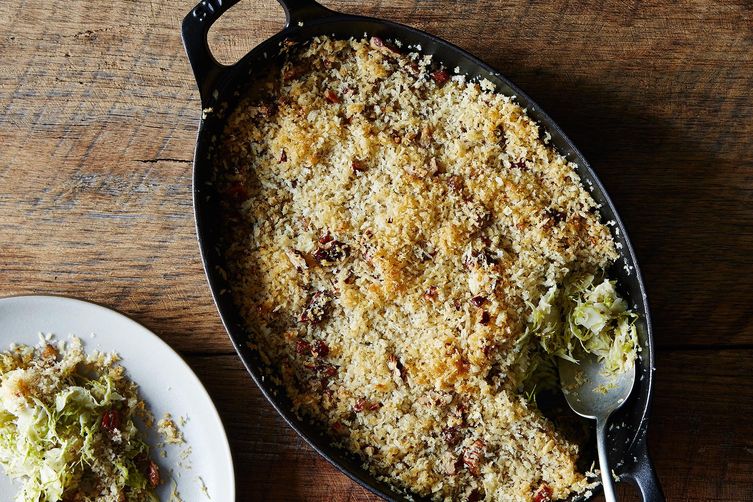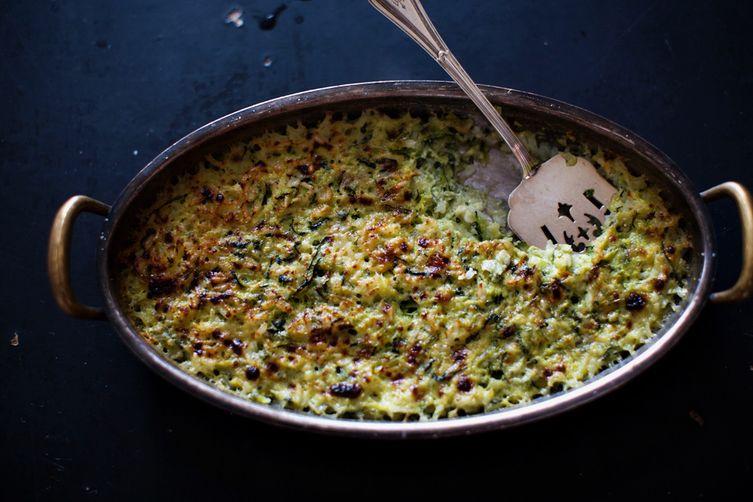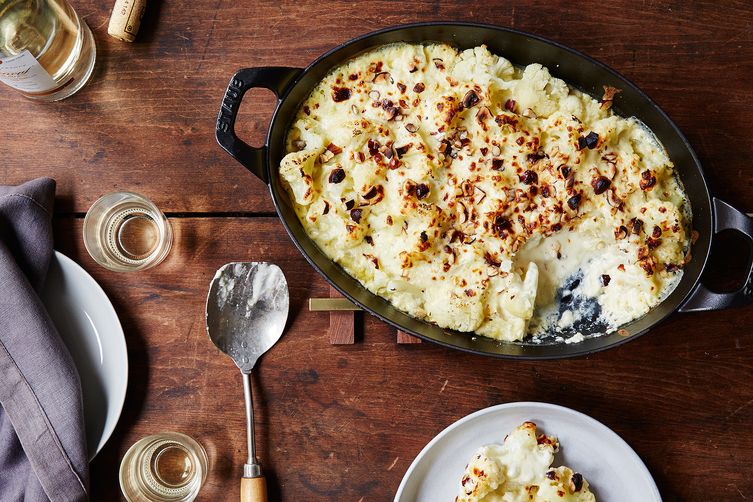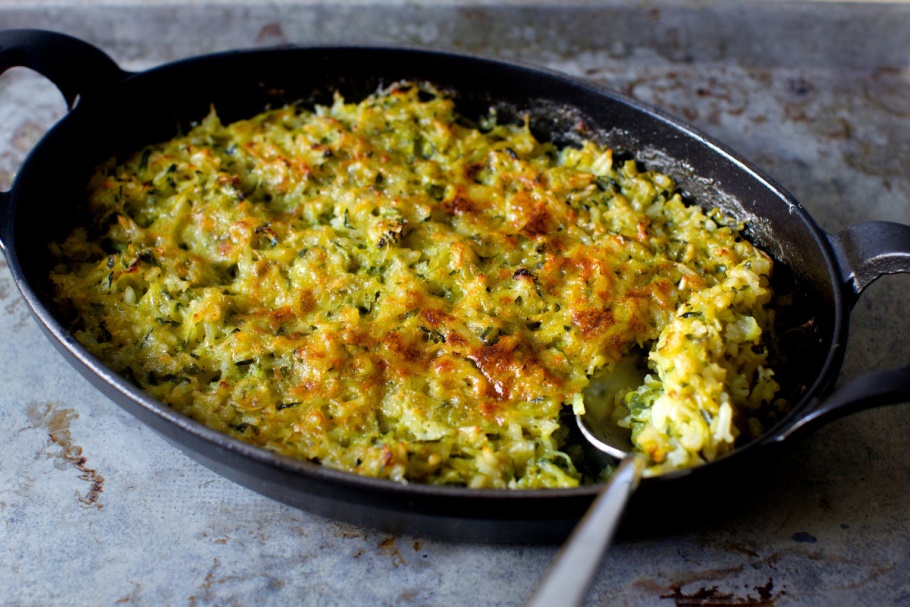Saturday Breakfasts, Winter, and Gratins: A Winning Combination!

Saturdays in winter are delicious times to create hearty hot breakfasts, don’t you think? I like to whip up a Saturday crowd-pleaser Friday morning or afternoon, when I’m prepping Friday’s dinner. It goes, covered, into the refrigerator to await its debut the next morning.
This Saturday morning meal is almost always a breakfast-casserole-type dish. Its fancy name is gratin. A gratin (sometimes written as gratinée or au gratin), is a very flexible dish, which makes it hard to classify under an exact name.

But, basic cooking manuals say that gratins are always baked in a shallow dish (sometimes called a “gratin dish”) and always topped with something that will crisp up when the dish goes into a hot oven or under a broiler, like cheese, buttery breadcrumbs, or a combination of both.
If you too, like the idea of planning a few winter breakfasts ahead of time, the gratin is the way to go. It’s a super easy and scrumptious approach to breakfast.

This word is actually derived from the French verb gratiner—to broil. Gratter (to scratch or scrape) is a close verb, and definitely suggestive of a gratin’s crispy crust. And in colloquial French, there’s the fun expression le gratin de la société—a.k.a., "the upper crust" (a fun fact to know and tell at the breakfast table).
Gratins sometimes come in disguise. The best known gratin dish is potatoes gratin (sometimes called pommes dauphinoises), and it’s best known for good reason: we love our potatoes and cheese. Bake layers of sliced potatoes in a dish, top with grated cheese, buttered breadcrumbs, or both, and when the spuds are cooked through, slide it under the broiler for a final scorch. You get the creamy potatoes, gooey cheese, and the crunchy breadcrumbs. This flavor and texture combination is as good as it gets.
But what else can you make into a gratin? It turns out we make a lot of gratins without realizing they’re gratins. A favorite site, www.food52.com, tells us all about it.

For instance, there's Julia Child’s very tasty rice-and-zucchini gratin, which, in Mastering the Art of French Cooking, Volume II, hides under the name “Tian de Courgettes au Riz.” (See recipe below.) It has at least as much zucchini as rice in it and is topped with a crispy, crispy layer of Parmesan cheese.
And turns out, many tians are gratins! The Food Lover's Companion says as much: Tians are usually composed of thinly sliced and layered vegetables, baked in a shallow dish, and topped with cheese and/or breadcrumbs (just like a gratin!).

You can see how your leftovers could easily shine in a gratin. While hard vegetables like potatoes, cauliflower, and squash are the most common and the most traditional, there are chicken gratins, seafood gratins, rice gratins, and gratins made with softer vegetables like tomatoes, eggplant, or zucchini—or leafy greens, like kale, chard, and spinach. (Even macaroni and cheese is also a sort of gratin when topped with breadcrumbs—the best part!)
So this winter, take a little extra time on Friday now and then, and put together a Saturday breakfast as you’re prepping your evening meal. Incorporate leftovers and let your imagination be your guide. But for starters, turn to this lovely zucchini and rice gratin (with maybe some cooked ham or crumbled bacon included), serve it piping hot with some fresh-squeezed juice or a delicious green smoothie. And as Julia would say, “Bon apetit!”

JULIA’S ZUCCHINI AND RICE GRATIN (serves 6)
PREPPING GRATED AND SALTED ZUCCHINI
2 to 2 ½ pounds zucchini
½ cup plain, raw, untreated white rice
1 cup minced onions
3 to 4 tablespoons olive oil
2 large cloves garlic, mashed or finely minced
2 tablespoons flour
2 ½ cups warm liquid: zucchini juices plus milk, heated in a pan (watch this closely so that it doesn't curdle)
2/3 cups grated Parmesan cheese, divided (save 2 tablespoons for later)
Salt to taste
Pepper to taste
2 tablespoons olive oil
A heavily buttered 6- to 8-cup, flameproof baking and serving dish about 1 1/2 inches deep
Shave the stem and the tip off each zucchini (or other summer squash), scrub the vegetable thoroughly but not harshly with a brush under cold running water to remove any clinging sand or dirt.
If vegetables are large, halve or quarter them. If seeds are large and at all tough, and surrounding flesh is coarse rather than moist and crisp, which is more often the case with yellow squashes and striped green cocozelles than with zucchini, cut out and discard the cores.
Rub the squash against the coarse side of a grater, and place grated flesh in a colander set over a bowl.
For each 1 pound (2 cups) of grated squash, toss with 1 teaspoon of salt, mixing thoroughly. Let the squash drain 3 or 4 minutes, or until you are ready to proceed.
Just before cooking, squeeze a handful dry and taste. If by any chance the squash is too salty, rinse in a large bowl of cold water, taste again; rinse and drain again if necessary. Then squeeze gently by handfuls, letting juices run back into bowl. Dry on paper towels. Zucchini will not be fluffy; it is still dampish, but the excess liquid is out. The pale-green, slightly saline juice drained and squeezed out of the zucchini has a certain faint flavor that can find its uses in vegetable soups, canned soups, or vegetable sauces.
ASSEMBLING GRATIN OF ZUCCHINI, RICE, AND ONIONS WITH CHEESE
While the shredded zucchini is draining (reserve the juices,) drop the rice into boiling salted water, bring rapidly back to the boil, and boil exactly 5 minutes; drain and set aside.
In a large (11-inch) frying pan, cook the onions slowly in the oil for 8 to 10 minutes until tender and translucent. Raise heat slightly and stir several minutes until very lightly browned.
Stir in the grated and dried zucchini and garlic. Toss and turn for 5 to 6 minutes until the zucchini is almost tender.
Sprinkle in the flour, stir over moderate heat for 2 minutes, and remove from heat.
Gradually stir in the 2 1/2 cups warm liquid (zucchini juices plus milk, heated gently in a pan -- don't let it get so hot that the milk curdles!). Make sure the flour is well blended and smooth.
Return over moderately high heat and bring to the simmer, stirring. Remove from the heat again, stir in the blanched rice and all but 2 tablespoons of the cheese. Taste very carefully for seasoning. Turn into buttered baking dish, strew remaining cheese on top, and dribble the olive oil over the cheese.
About half an hour before serving, bring to simmer on top of stove (you can skip this step if your baking dish isn't flameproof), then set in upper third of a preheated 425-degree F oven until tian is bubbling and top has browned nicely. The rice should absorb all the liquid.
- www.thetiffanyproject.com
- www.wsj.com
- www.food52.com
- www.smittenkitchen.com
 Alice Osborne
Alice Osborne
Weekly Newsletter Contributor since 2006
Email the author! alice@dvo.com
